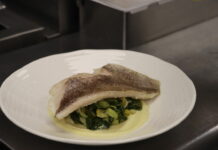When Nina Compton was a fledgling N’Orleanian, a friend offered her crawfish bisque at Easter time. The idea underwhelmed Compton, who helms Compère Lapin in the city’s warehouse district. “I’m thinking to myself, ‘I’ve had crawfish bisque a thousand times. What’s so special about yours?’” she recalls. But the execution amazed her. “It was unlike anything I’ve ever seen. They stuffed the meat back into the fish heads,” she says. “When I tasted it, I tasted the layers of flavor.”
Stepping into the New Orleans food scene can be daunting, even for a “Top Chef” celebrity like Compton. Take gumbo: “We’ll never put gumbo on the menu,” she asserts. “It’s a pride thing. Everyone thinks their gumbo is the best.”
Compton’s Caribbean cooking style is a good fit for this city, known for its Creole cuisine, fried oyster po’boys and hot beignets caked in melting powdered sugar. Her pepper pot, a signature dish at Compère Lapin, is local seafood in a warm broth redolent of coriander and basil, the bite of mint and cilantro, and a whiff of lemongrass.
Compère Lapin, named for a trickster rabbit in children’s fables from Compton’s native St. Lucia, is just one of several New Orleans restaurants run by women, a storied tradition that started with Elizabeth Kettenring Dutreuil Begue, who came to the French Quarter from Germany in 1853, and, with two consecutive husbands, ran a coffee exchange that offered up a late breakfast to dock workers. “She served at 11 a.m. to only 30 people seven days a week,” says Poppy Tooker, food writer and host of the radio show “Louisiana Eats!” By the turn of the century, during “the gilded age of tourism,” says Tooker, “people would arrive by train, and before they went to their accommodations, they’d go to Begue’s to see if there was a coveted seat available.”
At some point after the woman who invented brunch died in 1906, Tujague’s restaurant, located down the street, took over Begue’s building, and Clemence Castet, the wife of one of the new owners, took over the kitchen. “People remember her sitting at the cash register,” says Tooker. “Everyone always referred to her as ‘The Madame.’”
Tujague’s was one of many delectable stops on my summertime visit to New Orleans with a gentleman friend. The restaurant is reputedly the birthplace of the crème de menthe-based grasshopper, but I chose another iconic New Orleans cocktail, the viéux carré—an early name for the neighborhood in which we sat—before digging into a classic wedge salad with fried oysters. Madame Begue’s brother was a butcher, so meat is a longstanding staple at Tujague’s. The brisket is not to be missed.
As a Big Easy neophyte on a short trip, I was easily enchanted by the beery stench and clamor of Bourbon Street, the wrought iron balconies and glittering antiques on Royal Street and the cultivated commerce of Magazine Street. As a traveler who collected advice from the very best sources (foodies, journalists, even a friend who’d been a regular on David Simon’s HBO series “Treme”), I came prepared with reservations at modish restaurants and tips on where to find real music. (We landed in the French Quarter to the sounds of a ragtag street band, and closed out our trip hearing trumpeter Kermit Ruffins and the assorted musicians who step in to join him every Thursday at Bullet’s Sports Bar on Turead Ave.)
 What we didn’t do was stumble alongside a Mardi Gras parade or sway to jazz under a tent. Visiting New Orleans in July is not for cool-weather devotees, but it’s the perfect time for the crowd-averse. Even the line for beignets at Café du Monde—a must for even the most worldly wise visitors—moved at a clip, and we were seated at a clean table within minutes.
What we didn’t do was stumble alongside a Mardi Gras parade or sway to jazz under a tent. Visiting New Orleans in July is not for cool-weather devotees, but it’s the perfect time for the crowd-averse. Even the line for beignets at Café du Monde—a must for even the most worldly wise visitors—moved at a clip, and we were seated at a clean table within minutes.
We stayed in the 35-room Hotel Catahoula in the city’s financial district, a short walk from the French Quarter. The youthful clientele most likely appreciates the boutique hotel’s mixologist and barista, while overlooking the lack of drawers or closets in its guestrooms. The spare décor was somewhat disrupted by my open suitcase and dresses hanging from hooks on the wall.
We spent our two-plus days in New Orleans walking its neighborhoods on our way to food. On day one, we wandered the French Quarter, stopping at Manheim & Pugh Antiques, where I admired a diminutive crystal Baccarat basket chandelier, circa 1870, and left the store clutching the salesman’s card, on which he’d scrawled the “just for you” discounted price of $26,000.
We had lunch at Galatoire’s, popular among New Orleans businesspeople and old families: jackets for the men, pearls for the ladies. In a lame attempt to conserve space for an anticipated multicourse dinner, I ordered the crabmeat omelet. Later, Poppy Tooker told me that in the 19th century “eggs were one of the most expensive forms of protein. Omelets were very luxurious.” Omelets are also considered a litmus test for a skilled chef, and this one passed muster.
After lunch—and a brief siesta at our hotel—we walked through Louis Armstrong Park to the Treme. The neighborhood is a mix of bungalows and shotgun houses, some with grass sprouting from shingles still damp from Katrina, others in the throes of tasteful renovation. The David Simon spotlight may have helped spark interest in the ’hood. (I admit that a walk there wouldn’t have been on my radar without a prod from HBO.) Our stroll took us toward the Mississippi, into the Marigny neighborhood, more upscale now than when Stanley Kowalski bellowed to his wife, Stella, from outside their steamy apartment.
We ended up on Frenchmen Street, known for its music venues. Parched from our walk, we ducked into The Spotted Cat, one of the few bars with music wafting forth (it was only 4 p.m., after all). We sat at the nearly empty bar and ordered tall glasses of beer, and, in air-conditioned comfort, listened to a languorous blues band complete with trombone and double bass. It turns out the renowned jazz venue picks up considerably at night, but we already had plans for the evening, involving, of course, food.
Dinner was an Uber ride from our hotel to the Garden District, a neighborhood, as its name suggests, of grand houses on tree-lined streets. The main thoroughfare is Magazine Street, lined with tasteful home décor shops, Barre studios, coffee shops and handbag boutiques—as well as small grocery stores that sell things like local jerky and small-batch cane sugar soft drinks. (The following day, we had lunch there at Shaya, a new Israeli restaurant still reeling from its James Beard designation as Best New Restaurant of 2016.)
But this night was for Coquette. Kristen Essig recently left her executive chef gig at Meauxbar and Cavan restaurants to join her boyfriend, Maryland native Michael Stoltzfus, in running the Magazine Street bistro. She stopped at our table to say hello, and encouraged us to go for the five-course blind tasting, a $70 option that is a great way to bypass having to choose from the tantalizing options. The parade of plates (derived from the menu) included cobia, a firm white fish, with thinly sliced peaches and crème fraîche; Gulf shrimp with chorizo and grits; and luscious buttery lamb with corn and a wedge of fresh farmer’s cheese. The small rowhouse-style restaurant has a long bar lit by a collection of glittering chandeliers—stylish and homey, befitting of the neighborhood (though my guess is the lighting is not Napoleon-era Baccarat).
Essig is an enthusiastic booster of her adopted city and its restaurants. New Orleans’ gastro tourists (like me) create an atmosphere of abundance for the local dining scene. “There’s so much business to go around,” she says. Essig keeps a list of suggested restaurants for customers to try next. Her go-to is Herbsaint, where Rebecca Wilcomb is chef de cuisine. “I go there when I want to sit at the bar and have a nice glass of wine and just be left alone,” Essig says. “Unless Rebecca comes out and joins me.” She also recommends snowballs from Sno-Bliz, a 77-year-old family company currently run by her friend, the founders’ granddaughter, Ashley Hansen.
Essig considers it a compliment to be compared to actress Kim Dickens’ character on “Treme.” “I get that a lot,” she says. But the real model for the show’s chef Janette Desautel is Susan Spicer, who owns Bayona in the French Quarter. Spicer, says Essig, “is one of the amazing women I get to look up to.” New Orleans is filled with strong personalities, she adds, “and some of the strongest happen to be women.”
 To Eat:
To Eat:
Café Du Monde. Beignets and coffee live up to the hype. 800 Decatur, cafedumonde.com
Compère Lapin. Nina Compton’s St. Lucian-influenced cuisine. 535 Tchoupitoulas, comperelapin.com
Coquette. Inventive New American at a pretty Garden District bistro. 2800 Magazine, coquettenola.com
Galatoire’s. Established in 1905 and known for Creole cuisine. 209 Bourbon, galatoires.com
Shaya. Chef Alon Shaya’s Israeli restaurant was awarded Best New Restaurant by the James Beard Foundation in 2016. 4213 Magazine, shayarestaurant.com
Tujague’s. French Quarter landmark, with cookbook by Poppy Tooker (pictured). 823 Decatur, tujaguesrestaurant.com
To Sip:
Sazerac Bar at the Roosevelt Hotel. Huey Long once held court in this art deco watering hole. 130 Roosevelt Way, therooseveltneworleans.com
Bullet’s Sports Bar. A corner bar in the Treme neighborhood that features New Orleans musicians. 2441 A P Tureaud.




